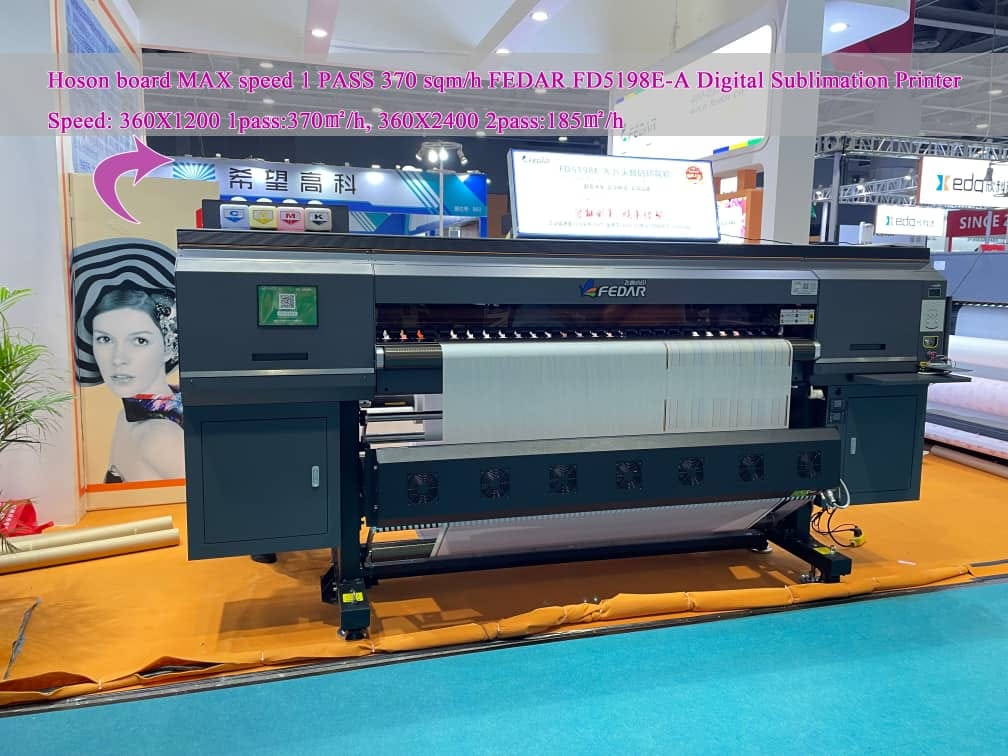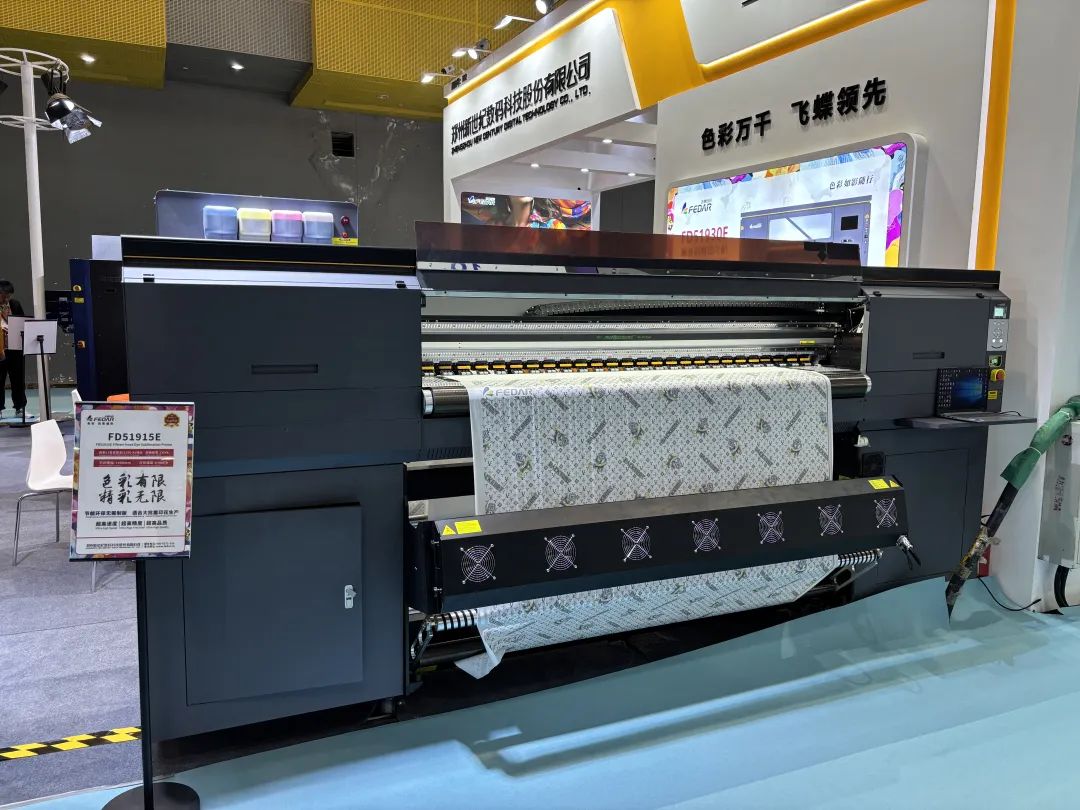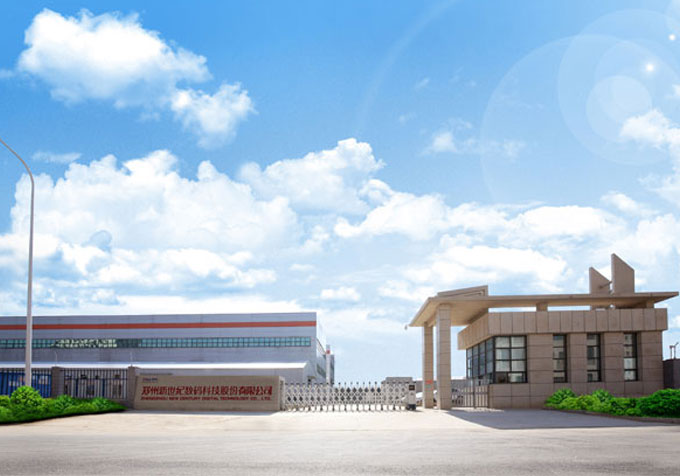Learn the key steps of dye sublimation printing, the equipment required, and its value in the market to provide a comprehensive guide for your business.
The science behind dye sublimation printers makes them an ideal choice for printing on polyester and similar materials. Utilizing wide-format inkjet or industrial dye sublimation printers, dye sublimation inks are applied to specialized transfer paper. This printing process allows for direct transfer of the prints onto fabric rolls or garments.
During the heating process, polymers bond with the fabric, permanently embedding designs, graphics, or text. The inks are resistant to fading, peeling, and deterioration over time, making them perfect for high-traffic areas.
This guide provides essential information about fabric dye sublimation printers, helping you determine whether this technology is suitable for your business. Let’s dive in!

What is Dye Sublimation Printing?
Dye sublimation printing involves applying images to fabric using heat transfer inks. This process employs a special type of ink containing dispersed dyes or pigments, which are then heat-pressed to create permanent, washable prints.
Dispersed dyes are chosen for their excellent adhesion to polyester fabric when exposed to high temperatures during the heat-pressing process. Dye sublimation inks offer a vibrant color gamut, including fluorescent hues, enhancing the overall color range of sublimation printing.
While other wide-format inkjet printers may share similar features, they are specifically designed for dye sublimation applications. The inks used are dispersed and tailored for printing on transfer paper, which is subsequently heat-pressed on to textiles.
Applications of Dye Sublimation Printers
Material-wise:
Dye sublimation technology is widely used in the printing industry, with polyester fibers being the most compatible. During heating, polyester fibers slightly melt, allowing for a strong bond with the dye and creating a permanent image transfer. Nylon, treated with additives to enhance dye absorption, can also be used effectively with this technology.
Industry-wise:
Dye sublimation printing produces high-quality images, making it an ideal choice for exquisite T-shirts and banners. This capability enables printing companies to offer a diverse range of products that cater to customers seeking top-quality results.
Additionally, dye sublimination printers excel at capturing stunning details, providing accurate physical representations of digital designs. This opens up new opportunities for creating personalized products.
Banners: Polyester and PVC banners are well-suited for dye sublimation printing, allowing for images of any size based on printer capabilities. Fabric banners can be UV resistant, ensuring permanent images suitable for various applications.
Soft Labels: Soft labels represent another excellent use case for dye sublimation printing, enabling the production of flags, notices, and display items.
Interior Decoration: Customers purchasing banners may also seek interior decorations, printing logos, brands, patterns, and designs on various fabrics for home decor, such as curtains, tapestries, pillows, and wall coverings.
In summary, dye sublimation offers significant opportunities in commercial printing.

What Do You Need for Dye Sublimation?
To achieve dye sublimation printing, you will need:
A dye sublimation printer
Dye sublimation paper for transfer
Software to create compatible files
A heat press machine
A cutting mechanism, such as a rotary blade or cutting table
Suitability of different fabrics in dye sublimation printing
Polyester
Suitability: Polyester is the best choice for dye sublimation printing. It has a strong ability to absorb dyes and can form long-lasting colors and patterns.
Note: Make sure the polyester content of the used fabric is higher than 70% to ensure the best printing effect.
Nylon
Suitability: Nylon can also be used for dye sublimation printing, but it needs to be specially treated to increase the absorption capacity of the dye.
Note: Make sure that the nylon fabric is properly treated to avoid the inability of the dye to adhere effectively during the printing process.
Cotton
Suitability: Pure cotton fabrics are not suitable for dye sublimation printing because the dye cannot form a good bond with cotton fibers.
Note: If you want to use sublimation printing on cotton cloth, you can choose coated polyester cotton blended fabrics, or use dye transfer methods.
Polyester Blends
Suitability: Blended fabrics of polyester and other fibers (such as cotton and viscose) can be suitable for dye sublimation printing, especially blended fabrics with a high polyester content.
Note: Make sure the polyester content is sufficient to obtain a clear and long-lasting printing effect.
Special fabrics (such as sportswear, functional fabrics)
Suitability: Many sportswear and functional fabrics (such as quick-drying fabrics) are usually made of polyester and are suitable for dye sublimation printing.
Note: When selecting fabrics, ensure their heat resistance and durability to meet the requirements of printing and subsequent use.
Summary of notes
Fabric pretreatment: Some fabrics need to be pretreated before printing to enhance the binding force of the dye.
Temperature and time: Make sure to use the right temperature and heating time to avoid damaging the fabric or causing poor printing results.
Print design: Consider the characteristics of the fabric when designing, and choose suitable colors and patterns to ensure the best presentation effect.
Test samples: Before large-scale production, it is recommended to conduct a small-scale test print to confirm the effect.

Why Choose Dye Sublimation?
Dye sublimation can produce stunning, high-quality graphics and images that faithfully represent the original design. The dyes are embedded into the fabric, ensuring long-lasting effectiveness for both indoor and outdoor use.
The lifespan of dye sublimation printed products is remarkable, with images that do not fade, peel, or degrade. For outdoor use, UV-resistant dyes can be specified to further extend image longevity.
Is Sublimation Worth the Investment?
Absolutely! The demand for printed textiles is rapidly increasing, and dye sublimation technology offers superior product quality. This method also allows for a broader range of product creation.
Like any printing process, dye sublimation has its pros and cons. However, if your goal is to print high-resolution, permanent images on textiles, there is no alternative that compares.
Contact us to explore the impactful world of textile printing with dye sublimation printers.
If there's anything we can do to further showcase machines' features, please let us know.
Email: sale@fedar.net
Whatsapp:
http://wa.me/8615515715397 Our company has over 30 models of printers with independent intellectual property rights and patents. Marketed under the esteemed brands of
Skycolor,
Stormjet, and
Fedar brands, these printers cover a wide range, including digital textile printers, UV printers, eco-solvent printers and more. Known for their exceptional quality and performance.





